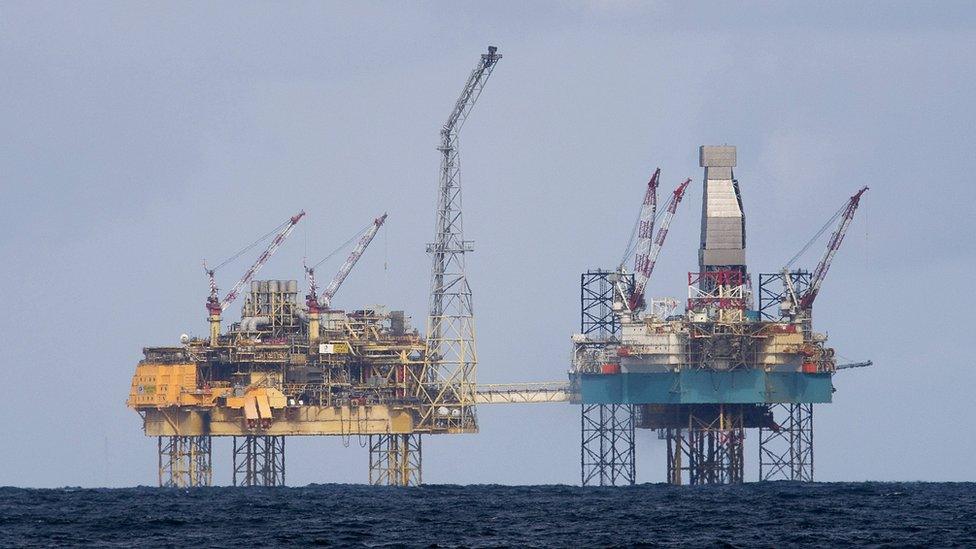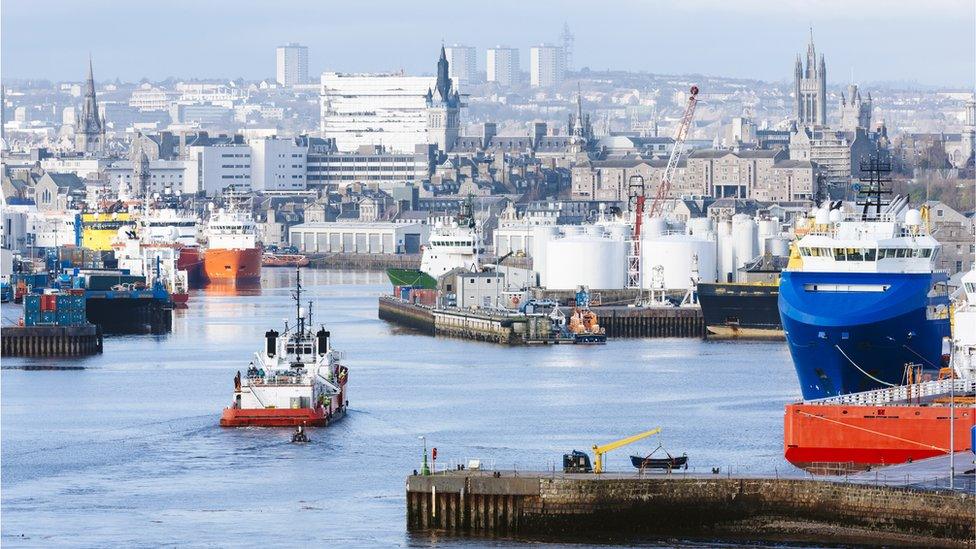North Sea oil and gas spend 'could still be £330bn'
- Published
- comments

The calculations are based on oil prices remaining close to their current level
Up to £330bn could be spent on extracting oil and gas from UK waters over the next three decades, according to leading industry experts.
Prof Alex Kemp and Dr Linda Stephen at Aberdeen University have used new data to model the potential for the offshore industry until 2050.
The study concludes that there could be 17 billion barrels of oil or the equivalent gas still to be extracted from offshore fields.
This is in addition to more than 43 billion barrels produced since the 1970s.
Prof Kemp and Dr Stephen have applied new data to their economic modelling of the sector, to test whether it can meet ambitious targets set by the industry, government and the new regulator, the Oil and Gas Authority.
This finds that the targets are achievable, but only under favourable conditions for the industry - on price, cost, funding and technical progress over the decades. Exploration would have to continue at recent levels of both drilling and success if this is to be achieved.
Such an outcome would mark a turnaround from the decline seen in production and in spending since the oil price slumped in 2014, though there would still be a long-term decline in spending and output.
With oil recently trading close to $80 per barrel, stability and some new optimism have returned to the industry.

The report indicates the potential value of economic activity in the North Sea industry
Investment from before 2014 has, as expected, reversed the decline in total production, at least for a few years. Private equity investors have shown confidence in the mature fields of the North Sea, by buying over assets from more established energy companies, and this week saw approval of two major investment projects.
Since the 2014-15 industry slump - following the decline in the price of a barrel of North Sea Brent crude from $115 to as low as $30, costs have been sharply reduced, though there remains concern that an upturn in activity could spark a return to supply chain inflation.
Prof Kemp's analysis assumes that such prices remain stable, and that the current tax regime is retained, while his figures are at current prices. He also assumes the industry continues to improve its performance in raising the percentage extracted of potential oil and gas.
He has run the economic model on different assumptions, one of which imagines the price of a barrel of North Sea oil is $60, with a therm of gas at 55 pence.
That is forecast to deliver £272 billion of spending on developing offshore fields and then producing from them. In addition, Prof Kemp points to decommissioning spend of £53bn by 2050. It is reckoned that might lead to production of nearly 15 billion barrels of oil and the equivalent gas.
Higher prices
The other price level modelled is a barrel of oil at $70 and gas at 60 pence, meaning profits would be higher and more investment would be made. That might lead to production over 32 years of more than 17 billion barrels.
Behind that achievement would be £158bn of spending on developing fields, and a further £172bn on operating them while producing, totalling £330bn. Under that scenario, decommissioning costs would be slightly higher, at £55bn.
"When decommissioning expenditures are added to development and operating costs, the aggregate exceeds recent levels for a few years, then declines at a modest but persistent rate to around £6bn in 2050," says the academic study. "The claim on the resources of the supply chain or the related opportunities remains very substantial."
But the academic study notes there are significant "downside risks" to the modelled forecasts. It shows that one such risk, the ease with which investment capital can be secured, makes a significant difference to the outcome. A slight raising of the hurdle to get investment behind field development plans would reduce the highest estimate of production by nearly 10%.
There is the risk of supply chain inflation. There is a significant risk that technical advances may not unlock the substantial amount of projected oil production from so-called 'technical fields', which are not yet seen as viable, and about which there is a limited amount of information.
The economic modelling does not produce an estimate of the amount of tax that would be raised by such levels of production. The scale and use of offshore oil and gas tax revenue has been the subject of extensive political debate, particularly within Scotland.
- Published23 September 2018
- Published5 July 2018